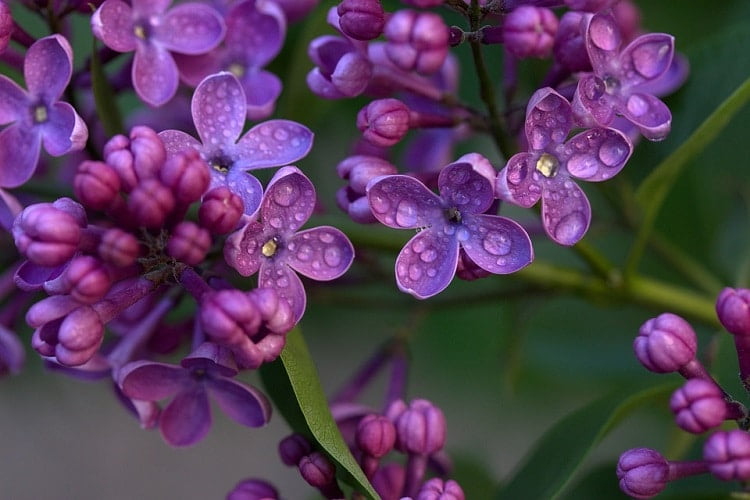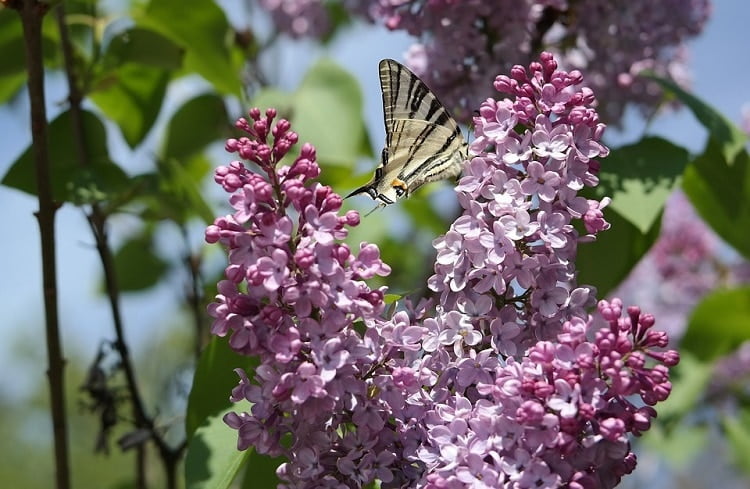
Why choose lilacs for your garden?
Lilacs grow in thick shrubs made up of individual canes full of flowers. The shrubs do not grow too tall, so you can easily pick up the canes. Lilacs make great cut flowers, as they are perfect table decorations you can place in vases or glasses. You can get as creative as you like and create scented wreaths, or just tie them up with a nice bow and offer them to someone. Learning how to grow lilacs is essential if you want to spice up your garden. These plants will reach their peak in summer, when they spread their fragrance as the evening comes. They stay in bloom for an average of six weeks but, depending on the variety you choose, this period may vary. The flowers also come in different colors, but you are probably most familiar with the purple breed.What to know before planting
You have decided you want these amazing flowers in your garden. Before learning how to grow lilacs, you should first take care of a few details. This will ensure your experience will go smoothly, and your plants will grow thick and bushy.Choose the variety
The first thing you should do is decide what variety of lilac you want in your garden. When picking the variety you like, do not look only at the color. The height of the plant is important as well, so make sure you pay attention to all the details. You can purchase a bare-root plant from a special plant nursery, or get a sapling from someone who already has full-grown lilacs in their garden. Before planting, these tiny saplings will need a little soaking. Place their roots in water for 10 or 15 minutes. If the roots are tangled, you should separate them and allow them to grow properly. This basically applies for dormant lilacs, but any type of root will probably need soaking.Choose the soil
When learning how to grow lilacs, it’s important to know what kind of soil is suitable for the plant. This way, your plant will grow more quickly and develop beautiful blooms. You will need a really fertile soil that is rich in humus. If its fertility isn’t the best thing, you can add some compost and make it a friendly environment for the plant. Also, the soil should be rich in humus that you can add yourself if it isn’t already endowed. Pay attention to the pH, as it’s really important for the lilacs. Anything from neutral to alkaline will be ideal, and it should be near 7.Choose the spot
The spot where you plant the lilacs is also important for the development of the plant. First of all, you should make sure it drains well. Do not let the roots soak, as the lilac will no longer bloom, or it will bloom a lot slower. Improvise a draining system in case the soil gets too moist. Now, choose a well-lit spot where the plant will get enough sun. When learning how to grow lilacs, you will find out it is really fond of full sunlight. Therefore, plant it where it can get at least six hours per day of sunlight. This is extremely important for the well-being of the blooms, as the flowers won’t be there in a shady spot.
Choose the timing
The last thing you need to consider before planting is the time when you should do it. Lilacs develop well both during spring and during autumn. However, if you want an impressive shrub in no time, it’s better to choose the autumn planting.How to plant lilacs
Once you’ve taken care of all the details, it’s time to start the planting. Here are a few things you should know when learning how to plant lilacs.Prepare the holes
You have chosen the ideal soil and the spot where you’ll plant the lilacs. Dig some shallow holes for the saplings and their roots. As long as the hole can cover the roots, it is deep enough. If you are planning to plant more bushes, space each hole from 5 to 15 inches apart from each other. It’s important to know how big they will grow, so that you’ll know how far away from each other they need to sit.Add the saplings in the holes
Carefully place the tiny lilacs in the holes you have prepared, and fill them with soil only halfway. Before adding the rest of the soil until you fill the hole, add some water. When you level up the hole, make sure you don’t go upper than the base of the plant. By doing this, you will risk killing it even from the beginning.When is the Best Time to Plant Black Cherries and How to Care for Them?
Planting black cherries is best done in the late fall or early spring, when the soil is moist and the climate is cool. Choose a sunny spot and ensure the soil is well-draining. Dig a hole that is wide and deep enough for the root system. Once planted, water regularly, especially during dry spells. Apply mulch to conserve moisture and deter weeds. Prune annually to maintain a healthy tree.
How to care for lilacs
At this point, the planting is done. If you used a sapling taken from a fully-grown lilac shrub, it might not look too appealing at first. Also, it might take some years until the plant will grow thoroughly and make fragrant blooms. To make sure everything will go smoothly, take good care of the lilacs.Watering
During summer, water the lilacs a few times a week. However, if you live in a region where there is a lot of rain, you can stop this practice to avoid overwatering. Add the water near the base of the plant, and let the soil absorb it. If you have to water the plant again, wait until the soil dries out properly.
Fertilizing
Apply some compost or fertilizer at the base of the plant, and then add some mulch on top. This will protect the lilacs against weeds and pests, while also keeping the soil relatively moist and absorbent. Do this every spring and, in some cases, as soon as the lilacs bloom. However, make sure you don’t overdo the fertilizing.Pruning
When doing the pruning, choose those branches that are the oldest and reach closest to the ground. Do this during winter, or even during spring. However, don’t do it after they have already bloomed. Make sure you don’t cut over one third of all the branches if it’s not absolutely necessary. This means you can cut as much from the plant only if the branches are already dead. Therefore, all the affected branches will need cutting as soon as you spot them. By doing this, you’ll make place for new flowers, and will preserve the plant’s resources to rebloom. For a more fruitful flower production for next year, you should redo the pruning during autumn, as soon as the current flowers fade out. Pay attention to how you perform this operation, to avoid leaving the plant barren.Taking care of diseases and pests
When learning how to grow lilacs, you should also learn how to take care of the plants and protect them from pests. Lilacs are quite sturdy, and are not so sensitive to regular pests and diseases that attack most plants. Snails and slugs are their most common ‘predators’, but they are not so dangerous. One thing you might notice might be some white mildew with a powdery texture on its leaves and branches. This is quite common after extremely hot but humid summers. It might look unpleasant, but the pest doesn’t actually attack the plant.What else you need to know about planting lilacs
To make sure your shrubs will grow colorful and scented, you can apply a few tricks for the well-being of your plants. First of all, it’s important to maintain the shape of the bush, so trim it regularly without affecting the branches, but carefully remove all the suckers. Also, after the blooms are gone, sprinkle some manure and lime at the base of the shrub. Lilacs will get better flowers if you keep the grass from growing around the shrubs. Surround them with a special cloth for landscaping that will prevent any other plants from growing near the lilac. Then, place some stones or a thick layer of bark on top of this cloth. If you want to cut the lilac blooms, choose the moment when they look the most vivid and have the most beautiful perfume. As soon as you have cut the blossoms, place the branch in a vase full of water. You can also dry these blooms by keeping them hanging upside down in a dark and cold room.








